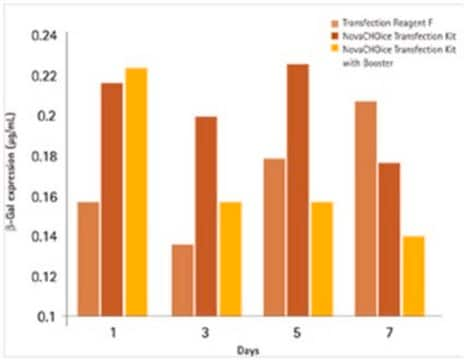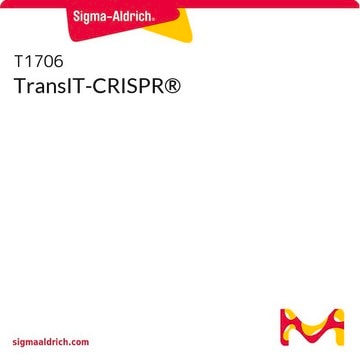NPT01
NeuroPorter™ Transfection Kit
Lipid formulation for nucleic acid transfections in neuronal and glial cells
Synonim(y):
NeuroPorter Transfection, Transfection Kit
About This Item
Polecane produkty
klasa czystości
for molecular biology
Poziom jakości
Postać
dried film
zastosowanie
kit sufficient for 75-200 transfections
dostępność
available only in USA, Canada and EU
metody
transfection: suitable
temp. przechowywania
2-8°C
Opis ogólny
Zastosowanie
- C6 glioma (human)
- Cortical neurons (rat primary)
- Dorsal Root Ganglion (DRG) cells (rat)
- NT2 neurons(human precursor cells)
- NT neurons (human differentiated cells)
- Subventricular Zone (SVZ) cells (mouse)
- White matter cells (mouse)
Cechy i korzyści
- Optimized for primary neurons, glial cells, and cultured neural cell lines
- Very low toxicity with no neuro-degeneration or dendrite withdrawal
- Efficient DNA delivery primary neurons, glial cells, and cultured neural cell lines
- Fast and easy to use compared to other methods
- Compatible with both serum and serum-free transfection protocols
Komponenty
1.5 mL Hydration Buffer H9036
7.5 mL DNA Diluent D1941
Przestroga
Zasada
Informacje prawne
produkt powiązany
Kod klasy składowania
12 - Non Combustible Liquids
Temperatura zapłonu (°F)
Not applicable
Temperatura zapłonu (°C)
Not applicable
Certyfikaty analizy (CoA)
Poszukaj Certyfikaty analizy (CoA), wpisując numer partii/serii produktów. Numery serii i partii można znaleźć na etykiecie produktu po słowach „seria” lub „partia”.
Masz już ten produkt?
Dokumenty związane z niedawno zakupionymi produktami zostały zamieszczone w Bibliotece dokumentów.
Klienci oglądali również te produkty
Produkty
Transfection introduces genetic material into cells, aiding research in gene expression and cell biology.
Transfekcja wprowadza materiał genetyczny do komórek, wspomagając badania nad ekspresją genów i biologią komórek.
This brief webinar provides an overview of what transfection is and the methods that are used to introduce DNA or RNA into eukaryotic cells.
Powiązane treści
Browse our convenient transfection reagent selection guide to match the best reagent for your specific cell line and application needs.
Nasz zespół naukowców ma doświadczenie we wszystkich obszarach badań, w tym w naukach przyrodniczych, materiałoznawstwie, syntezie chemicznej, chromatografii, analityce i wielu innych dziedzinach.
Skontaktuj się z zespołem ds. pomocy technicznej















